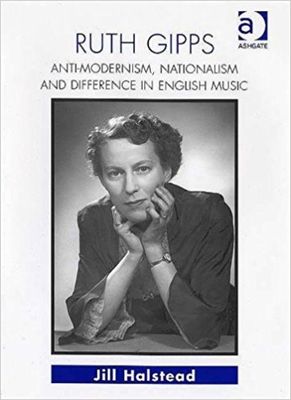Musical Meanings
four musical themes
In her study Ruth Gipps: Anti-modernism, Nationalism and Difference in English Music, Jill Halstead offers an extended analysis of Goblin Market and describes the specific ways in which Gipps conveys interpretations of the text through musical themes and gestures. Halstead identifies four principal musical themes that represent particular aspects of the narrative: “the ‘forbidden fruit theme,’ used to represent physical temptation; the ‘corruption theme,’ used to represent the depraved world of the goblins; the ‘warning theme,’ used to represent danger either physical or moral; and the ‘enchantment theme,’ used to represent innocence and naïvety” (p. 141). Gipps’s music is supple enough to indicate the mixed quality of things, conveying, for instance, both the enticing allure of the goblin fruits and the threat posed by them. In presenting the fruit, Gipps creates a very appealing sound that is underscored by an “ominous mood” (Halstead, p. 142).
warning and corruption
When the sisters are first introduced, a change in music is audible, with the tonal centre and rhythms becoming stable and regular, in contrast to the “irregular rhythms and shifting harmonies associated with the goblins” (Halstead, p. 143). The threat to the sisters is introduced musically into this state of innocence and calm with the first fragments of the “warning theme,” and Lizzie uses the “warning theme” again, now transposed up a tone, to caution Laura not to look at the goblins. Halstead identifies the “corruption theme” as “perhaps the most significant of the entire work” (p. 144). This theme first is heard when Laura looks at the goblins and describes them to Lizzie. The “corruption theme” is often sung by Laura (as, for example, when she describes for Lizzie the goblin fruits that she has tasted), and Halstead takes this as Gipps’s presentation of Laura as both “corrupted and corrupting” (p. 144). The “corruption theme” is also changeful. When it is first heard, it sounds “simple and unthreatening, reflecting Laura’s view of the goblins as rather harmless, cuddly creatures” (p. 144). The music indicates that Laura, in her innocence, is not aware of the danger that the goblins pose, a danger that is only heard musically when the “warning theme” is introduced upon Laura’s declaration that the goblins sound “kind and full of loves” (Rossetti, l. 79; Gipps and Rossetti, p. 15). Halstead points out that Laura’s encounter with the goblins is crafted to encourage the listener to take Laura’s perspective. Still failing to see the danger in the goblins, when Laura hears the goblins approach the dissonance that had been present disappears and they sound again non-threatening and enticing.
enchantment
Gipps also uses the musical themes in flexible and surprising ways. For instance, the “enchantment theme” manages to convey the “juxtaposition of innocence with experience and the nursery with the erotic” (Halstead, p. 146). The “enchantment theme” is first heard when Laura succumbs to the temptation of the goblin fruit. Surprisingly, this critical and dramatic narrative event is accompanied by an innocent-sounding slow waltz melody. The goblins address Laura singing in unison, recalling the simple character of the music when they first tempted their innocent victim. According to Halstead, “the enchantment theme also paints Laura in a more sympathetic light. To her the goblins are welcoming and friendly, she is child-like and ‘sweet-toothed’ and unaware of the consequences of giving in to temptation. The use of such a disarming musical gesture here encourages the listener to see the reasons for her fall as being curiosity rather than greed, naïvety rather than wickedness” (p. 146).
sensuality
Gipps also uses other significant musical gestures to indicate the ambiguous two-sidedness of physical experiences. Physical experiences such as “love/lust, pleasure/pain, virginity/intercourse” are musically presented as interconnected, demonstrating how “such fluidity may make the innocent vulnerable to corruption” (Halstead, pp. 146-47). Such gestures, according to Halstead, “bind the work together and draw out the erotic, sensual nature of the text” (p. 147). Gipps also uses a musical theme to connect the oral eroticism of sucking on goblin fruit to the physical closeness of the sisters when they crouch close together “With clasping arms and cautioning lips, / With tingling cheeks and finger-tips (Halstead, p. 148). This same musical theme returns at the point that the fruit and sisterly physical intimacy converge in Laura’s climactic kissing of Lizzie in order to drink in the curative goblin juices. Significantly, the “sensual nature of the mouth” is not musically reprised at the end. Instead, “when the spell of the goblins is broken and Laura’s breath becomes once again ‘as sweet as May,’” Laura’s recovered innocence is represented in “simple C major and D major triads sung by the chorus” (p. 148). Interestingly, although Lizzie resists the goblin men, the music suggests that she too is changed by their physical assault: she uses the “corruption theme” only once, when she asks Laura to “Hug me, kiss me, suck my juices” (Rossetti l. 468; Gipps and Rossetti, p. 70). Halstead sees in this a confirmation of “the idea that the stimulation of the senses through either pleasure or pain possesses a power to transform” (p. 148).
Source:
Halstead, Jill. Ruth Gipps: Anti-modernism, Nationalism and Difference in English Music. Aldershot, Ashgate, 2006.
next exhibit
- Polly Pen and Peggy Harmon's Goblin Market (1985)
- choose another setting of "Goblin Market"


